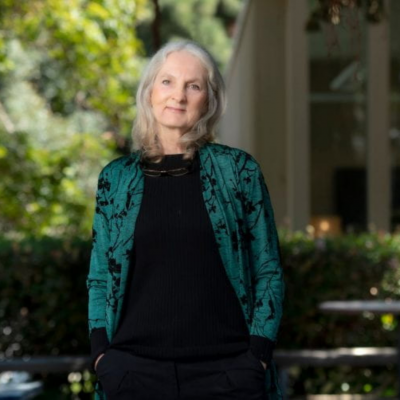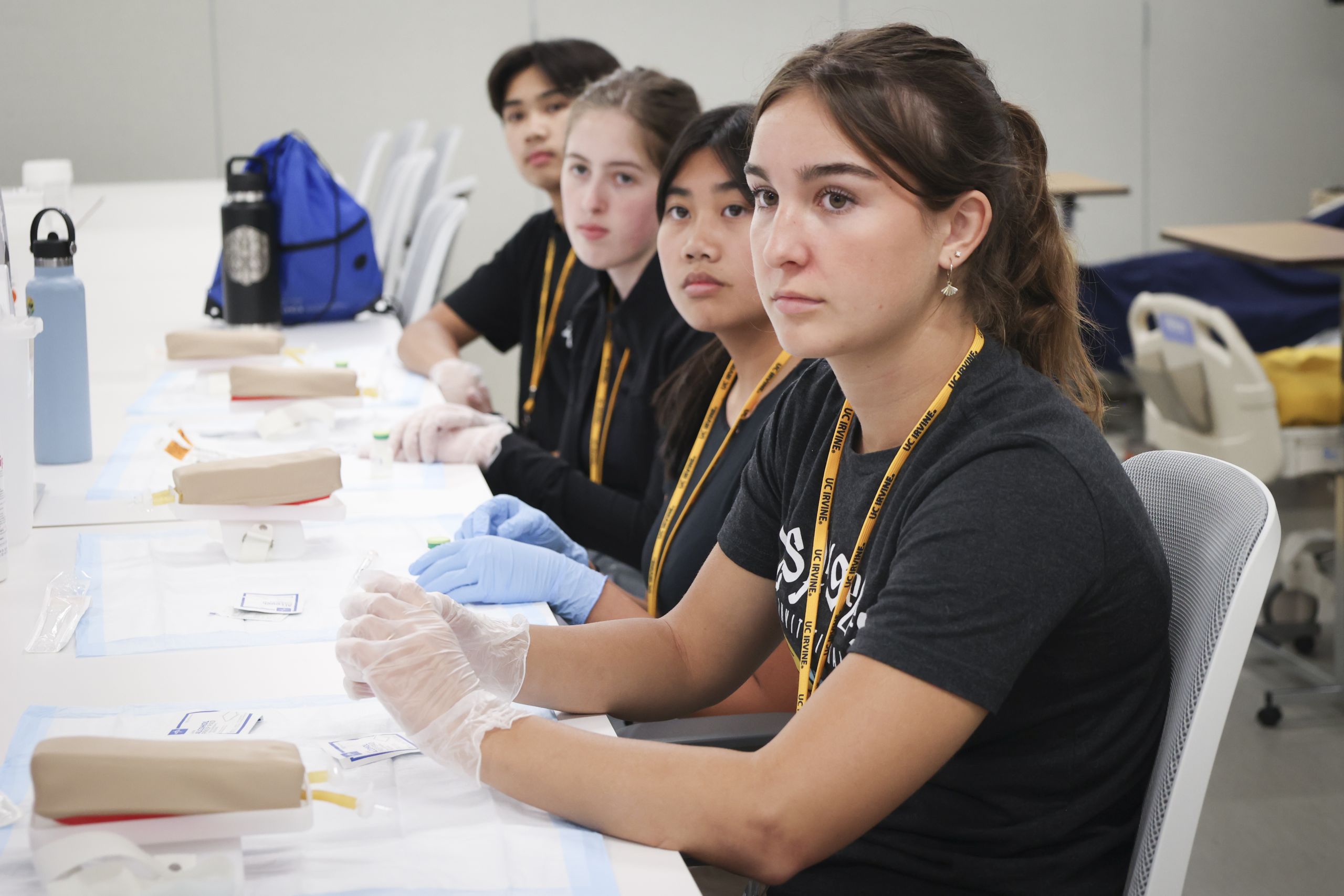 By Leonie Gombrich
By Leonie Gombrich
Professor E. Alison Holman was one of the very first group of faculty employed by UCI’s Program of Nursing Science – the degree program from which the Sue & Bill Gross School of Nursing originated.
As such, her work has helped shape a curriculum that reflects the school’s deep concern for health equity and community care.
She is, furthermore, a leader in her field, whose studies of collective trauma following catastrophic events speak directly to policymakers in state and national legislatures.
Climate and underserved populations
The multi-disciplinary study she is currently planning focuses on the compound physical and mental effects of climate-induced catastrophe on a vulnerable county in California.
Holman began teaching her graduate course, Compassionate Care for Underserved Populations, more than 10 years ago. In 2017, she incorporated “a section on climate change and its impact and who it affects most,” because “after Hurricane Harvey it became obvious that the communities hardest hit were the poorest people in Texas.”
This theme is the natural continuation of a body of published work that meticulously builds evidence around Holman’s lifelong question: “How do people cope with all this trauma?”
ICUs and the family unit
Her own nursing career began in a pediatric ICU, where she encountered on a daily basis the impact of children’s health emergencies on the wider family unit. It got her thinking about the group implications of traumatic experience – and how to deal with it.
“From my perspective, we had to take care of the family,” she explains. “We had to think about the psychological processes going on in the family’s minds. When her kid’s in ICU, yes, mom’s anxious! And we know that anxiety is the most contagious emotion – that’s a well-known psychological fact. You have a kid with asthma in ICU who is finally stable, it’s taken several hours to reach this point, then the anxious mom comes in and suddenly the kid is wheezing again. Bottom line is if you don’t pay attention to the family, you can’t fix the kid. The other nurses called me the psych nurse of the unit – because I always wanted to address the mental health aspect of being in an ICU.”
Frequently, however, it was the source of children’s injuries that made Holman feel frustratingly powerless to provide help that would make a lasting difference. Daily, she encountered families living with complex layers of difficulty and danger, in the midst of which was a child in crisis. These issues were outside the remit of an ICU nurse, and Holman felt that she needed to do more.
“So many of my colleagues just didn’t get the severity of trauma that families were experiencing,” she says. “Really bad things happen in the world.”
Understanding coping and cascading traumas
She decided to leave ICU nursing to investigate the interacting issues that underserved communities face, what this means for their health, and whether at least some of the traumatic impact on them could be prevented.
“It became my mission,” she recalls, “to understand how people deal with the overwhelming, sometimes cascading traumas in their lives. It remains my passion to this day.”
For her newest project, she intends to be part of a multi-disciplinary research team seeking to analyze the after-effects of a devastating fire on the community of a Californian county that “has an eight-year lower life expectancy than the state of California overall. These communities have a very high rate of mental health problems: suicides, suicide attempts.”
She further explains: “We’re working with engineers from the Mississippi State University. They have the resources to test the toxicity of the water, soil, and the air – so we can study the combined effects of physical toxicity with the mental health toxicity of being ignored or abandoned for years. I’m interested in understanding how the psychological process impacts the physical health of this community.”
The territory is reminiscent of her very first work as a graduate: on leaving ICU, she studied two California communities that lost more than 300 homes to wildfires in 1993.
“It was very climate related,” she points out, “although that was not my reasoning then. I was interested in perceptions of trauma – what we then called ‘community-based trauma’ – at the time.”
Building a health outcome predictive model
In her current study, the impact of climate change on human health is very much a specific focus.
“What we’ve seen over the course of the past 20 years is an acceleration in the rate of exposure to major collective events. The curve is going up. After a wildfire, the soil’s bad, the lake has been poisoned by toxic run-off – communities depend on that water for various functions – and then you get fire after fire. We’re going to model the accelerating pace of exposure. We’re looking to provide a predictor of mental and physical health outcomes in this county.”
Holman speaks with the authority of a researcher whose National Science Foundation-funded work with long-term colleague UCI psychology professor Roxane Cohen Silver is regularly shared with policymakers in Washington. For three decades, the research duo has ensured that all their studies involve representative samples of the American population, so that their results can be generalised with the necessary degree of confidence to argue for policy and law.
It’s work that is now informed by three decades’ worth of research in the field of collective trauma, beginning in 2001 with a study of the traumatic impact of the terrorist atrocities of 9/11.
Holman was on vacation in Nigeria, “not watching TV for a couple of weeks”, when the Sept. 11 attacks took place. The impact of discovering, via satellite media coverage at a friend’s home, what was going on in her home country, had an enormous effect on her.
“First thing, I didn’t believe it. I was massively affected. I couldn’t sleep for several nights. That was the moment I realised that this is a national collective trauma, and I had to do a study on it.”
Media imagery and its link to trauma
The studies that she carried out with Silver on 9/11 and, subsequently, the Boston Marathon bombing (2013) and natural disasters such as Hurricanes Irma and Harvey (2017), amassed evidence about the role of media imagery in accentuating and perpetuating collective trauma.
She explains: “Extensive media exposure sensitizes people, not desensitizes them. It’s since 9/11 that social media outlets have blossomed. In the aftermath of the Boston Marathon bombing, exposure to bloody images from the site increased the distress of those who saw them – and the more media people consumed, the more distressed they became. Those images light up the part of the brain associated with PTSD. As people become more worried, they become more attached to reporting of the event, and media outlets roll the worst, most eye-crashing pictures as they tell the story. It’s a negative cycle. And when you’re watching it in the media, you’re powerless to stop it — unless you turn it off.”
The distress caused by powerlessness is an enduring theme in Holman’s narrative – particularly powerlessness in a situation known as “moral distress”: where you can see what should be done but lack the means to do it. Her path to leadership has been driven by an archetypal nurse’s mission to follow the imperative to help others, and to help others help themselves.
‘A true compassionate stance’
Dealing with compound trauma and its after-effects can still be hard for her, too, she acknowledges. But these days, her own distress is somewhat ameliorated by a sense of having helped.
“Being able to share my findings with policymakers helps. Being able to hopefully have that influence on how people address the problems – that makes a difference to me. And teaching about compassion. That’s my biggest bridge to my students. Learn ways to work with people in underserved areas – you have to learn how to talk to people! Show respect and understanding. That takes a true compassionate stance.”
Holman is not backing off her mission any time soon. If anyone has the power to reduce trauma by reducing the causes of trauma, she implies, then why would they not use that power? In her new study on the compound results of climate change-related disaster, she knows she is investigating the biggest potential cause of trauma in our times.
“Human-caused harm causes a stronger [trauma] response than natural hazards,” she says. “And climate change is creating a much thinner line between the two. The traumatic effects are increased because we see people and government agencies not doing anything about it, and we want them to.”
For more information or to support a future nurse or nurse-led research, please connect to Juliana Goswick, Director of Development at jgoswick@hs.uci.edu or visit Giving.




Leave A Comment